GRADUATE
HERE WE GRADUATE!! WE OFFER BEST TUTORIAL SERVICES
- 236
- 0
- 1
Community
- Followers
- Following
17 Reviews received
237 items
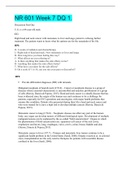
NR 601 Week 7 DQ 1. | GRADED A
NR 601 Week 7 DQ 1. Discussion Part One C.G. is a 69-year-old male CC: Right head and neck cancer with metastasis to liver and lungs; patient is refusing further treatment. The patient wants to know what his options are for the remainder of his life. HPI: O- 6 weeks of radiation and chemotherapy L- Right side of head and neck. Now metastasis to liver and lungs. D- How long have you been feeling this way? C- What effects are you referring to? A- Is there anything that makes the s...
- Case
- • 3 pages •
NR 601 Week 7 DQ 1. Discussion Part One C.G. is a 69-year-old male CC: Right head and neck cancer with metastasis to liver and lungs; patient is refusing further treatment. The patient wants to know what his options are for the remainder of his life. HPI: O- 6 weeks of radiation and chemotherapy L- Right side of head and neck. Now metastasis to liver and lungs. D- How long have you been feeling this way? C- What effects are you referring to? A- Is there anything that makes the s...
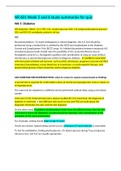
NR 601 Week 5 and 6 study summaries for quiz
NR 601 Week 5 and 6 study summaries for quiz Wk 5: Diabetes DM diagnosis; HbA1C >6.5, FPG: 125, random glucose>200, 2 hr postprandial plasma glucose> 200, and DM S/S; polydipsia, polyuria, wt loss A1C Recommendations c To avoid misdiagnosis or missed diagnosis, the A1C test should be performed using a method that is certified by the NGSP and standardized to the Diabetes Control and Complications Trial (DCCT) assay. B c Marked discordance between measured A1C and plasma glucose leve...
- Exam (elaborations)
- • 24 pages •
NR 601 Week 5 and 6 study summaries for quiz Wk 5: Diabetes DM diagnosis; HbA1C >6.5, FPG: 125, random glucose>200, 2 hr postprandial plasma glucose> 200, and DM S/S; polydipsia, polyuria, wt loss A1C Recommendations c To avoid misdiagnosis or missed diagnosis, the A1C test should be performed using a method that is certified by the NGSP and standardized to the Diabetes Control and Complications Trial (DCCT) assay. B c Marked discordance between measured A1C and plasma glucose leve...
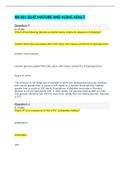
NR 601 QUIZ MATURE AND AGING ADULT
NR 601 QUIZ MATURE AND AGING ADULT Question 1 2 / 2 pts Which of the following laboratory results meets criteria for diagnosis of diabetes? random blood glucose greater than 126 mg/dL with classic symptoms of hyperglycemia positive urine ketones Correct! random glucose greater than 200 mg/dL with classic symptoms of hyperglycemia Hgb A1C 6.4% The criterion for the diagnosis of diabetes is either two fasting blood glucose readings with results greater th...
- Exam (elaborations)
- • 58 pages •
NR 601 QUIZ MATURE AND AGING ADULT Question 1 2 / 2 pts Which of the following laboratory results meets criteria for diagnosis of diabetes? random blood glucose greater than 126 mg/dL with classic symptoms of hyperglycemia positive urine ketones Correct! random glucose greater than 200 mg/dL with classic symptoms of hyperglycemia Hgb A1C 6.4% The criterion for the diagnosis of diabetes is either two fasting blood glucose readings with results greater th...
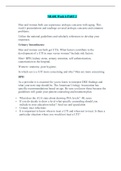
NR 601 Week 6 PART 2
NR 601 Week 6 PART 2 Men and women both can experience urologic concerns with aging. This week's presentations and readings covered urologic concerns and common problems. Utilize the national guidelines and scholarly references to develop your responses. Urinary Incontinence Men and women can both get UTIs. What factors contribute to the development of a UTI in men versus women? Include risk factors. Men= BPH, kidney stone, urinary retention, self catheterization, cauterization in the h...
- Exam (elaborations)
- • 7 pages •
NR 601 Week 6 PART 2 Men and women both can experience urologic concerns with aging. This week's presentations and readings covered urologic concerns and common problems. Utilize the national guidelines and scholarly references to develop your responses. Urinary Incontinence Men and women can both get UTIs. What factors contribute to the development of a UTI in men versus women? Include risk factors. Men= BPH, kidney stone, urinary retention, self catheterization, cauterization in the h...
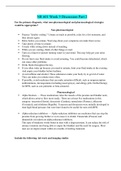
NR 601 Week 5 Discussion Part 2
NR 601 Week 5 Discussion Part 2 For the primary diagnosis, what non-pharmacological and pharmacological strategies would be appropriate? Non-pharmacological • Practice "double voiding." Urinate as much as possible, relax for a few moments, and then urinate again. • Relax before you urinate. Worrying about your symptoms can make them worse. • Take plenty of time to urinate. • Urinate while sitting down instead of standing. • While you are waiting, think of other things or read....
- Exam (elaborations)
- • 3 pages •
NR 601 Week 5 Discussion Part 2 For the primary diagnosis, what non-pharmacological and pharmacological strategies would be appropriate? Non-pharmacological • Practice "double voiding." Urinate as much as possible, relax for a few moments, and then urinate again. • Relax before you urinate. Worrying about your symptoms can make them worse. • Take plenty of time to urinate. • Urinate while sitting down instead of standing. • While you are waiting, think of other things or read....
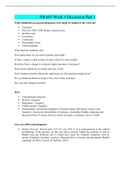
NR 601 Week 5 Discussion Part 1
NR 601 Week 5 Discussion Part 1 What additional assessments/diagnostic tests might be helpful in the work-up? • Urinalysis • PSA test, CBC, CMP, Kidney function tests • prostate exam • Cystometry • Cystoscopy • Neurological Tests • Ultrasonography When did this condition start? How many times do you need to urinate each night? Is there a large or small volume of urine when you void at night? Has there been a change in urination output (increase or decrease)? How much ...
- Case
- • 3 pages •
NR 601 Week 5 Discussion Part 1 What additional assessments/diagnostic tests might be helpful in the work-up? • Urinalysis • PSA test, CBC, CMP, Kidney function tests • prostate exam • Cystometry • Cystoscopy • Neurological Tests • Ultrasonography When did this condition start? How many times do you need to urinate each night? Is there a large or small volume of urine when you void at night? Has there been a change in urination output (increase or decrease)? How much ...

NR 601 Week 4 Soapnote | LATEST GUIDE
NR 601 Week 4 Soapnote Soap Note S. CC: increased dyspnea on exertion HPI: S.F is a 75year-old Hispanic male, who presents with increased dyspnea with exertion. Onset: one week ago Location: Lungs, chest Duration: one week ago, worsened in the past 3 days Characteristics: Coughing up a moderate amount of thick green sputum, pursed lip breathing Aggravating Factors: fever, chills, SOB Relieving Factors: increased fluids Treatment: ibuprofen, Spiriva inhaler Severity: Fever 10...
- Exam (elaborations)
- • 7 pages •
NR 601 Week 4 Soapnote Soap Note S. CC: increased dyspnea on exertion HPI: S.F is a 75year-old Hispanic male, who presents with increased dyspnea with exertion. Onset: one week ago Location: Lungs, chest Duration: one week ago, worsened in the past 3 days Characteristics: Coughing up a moderate amount of thick green sputum, pursed lip breathing Aggravating Factors: fever, chills, SOB Relieving Factors: increased fluids Treatment: ibuprofen, Spiriva inhaler Severity: Fever 10...
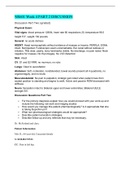
NR601 Week 4 PART 2 DISCUSSION
NR601 Week 4 PART 2 DISCUSSION Discussion Part Two (graded) Physical Exam: Vital signs: blood pressure 128/84, heart rate 80 respirations 20, temperature 98.5 height 5’3”, weight 130 pounds General: no acute distress HEENT: Head normocephalic without evidence of masses or trauma. PERRLA, EOMs intact. Noninjected. Fundoscopic exam unremarkable. Ear canal without redness or irritation, TMs clear, pearly, bony landmarks visible. No discharge, no pain noted. Neck negative for masses. No th...
- Case
- • 7 pages •
NR601 Week 4 PART 2 DISCUSSION Discussion Part Two (graded) Physical Exam: Vital signs: blood pressure 128/84, heart rate 80 respirations 20, temperature 98.5 height 5’3”, weight 130 pounds General: no acute distress HEENT: Head normocephalic without evidence of masses or trauma. PERRLA, EOMs intact. Noninjected. Fundoscopic exam unremarkable. Ear canal without redness or irritation, TMs clear, pearly, bony landmarks visible. No discharge, no pain noted. Neck negative for masses. No th...
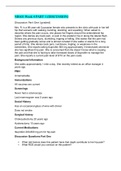
NR601 Week 4 PART 1 (DISCUSSION)
NR601 Week 4 PART 1 (DISCUSSION) Discussion Part One (graded) Mrs. R. is a 66-year-old Caucasian female who presents to the clinic with pain in her left hip that worsens with walking, bending, standing, and squatting. When asked to describe where the pain occurs, she places her fingers around the anterolateral hip region. She denies any back pain, or pain in the posterior hip or along the lateral thigh. Denies any previous injury, stumbling, tripping or falling. She states that the pain has be...
- Case
- • 6 pages •
NR601 Week 4 PART 1 (DISCUSSION) Discussion Part One (graded) Mrs. R. is a 66-year-old Caucasian female who presents to the clinic with pain in her left hip that worsens with walking, bending, standing, and squatting. When asked to describe where the pain occurs, she places her fingers around the anterolateral hip region. She denies any back pain, or pain in the posterior hip or along the lateral thigh. Denies any previous injury, stumbling, tripping or falling. She states that the pain has be...
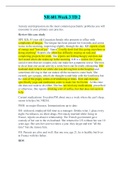
NR 601 Week 3 TD 2 | GRADED A
most common psychiatric problems you will encounter in your primary care practice. Review this case study
- Exam (elaborations)
- • 8 pages •
most common psychiatric problems you will encounter in your primary care practice. Review this case study

MATH 225N FINAL EXAM 2 – QUESTION AND ANSWERS
INET HESI RN V1 ACTUAL TEST SCREENSHOTS
INET HESI RN V1 ACTUAL TEST SCREENSHOTS
INET HESI RN V1 ACTUAL TEST SCREENSHOTS
INET HESI RN V1 ACTUAL TEST SCREENSHOTS